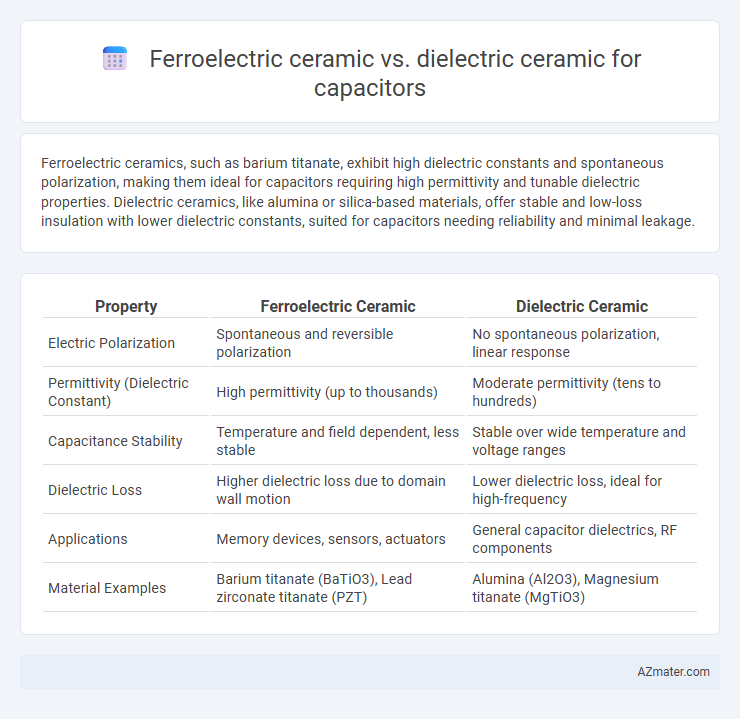Ferroelectric ceramics, such as barium titanate, exhibit high dielectric constants and spontaneous polarization, making them ideal for capacitors requiring high permittivity and tunable dielectric properties. Dielectric ceramics, like alumina or silica-based materials, offer stable and low-loss insulation with lower dielectric constants, suited for capacitors needing reliability and minimal leakage.
Table of Comparison
| Property | Ferroelectric Ceramic | Dielectric Ceramic |
|---|---|---|
| Electric Polarization | Spontaneous and reversible polarization | No spontaneous polarization, linear response |
| Permittivity (Dielectric Constant) | High permittivity (up to thousands) | Moderate permittivity (tens to hundreds) |
| Capacitance Stability | Temperature and field dependent, less stable | Stable over wide temperature and voltage ranges |
| Dielectric Loss | Higher dielectric loss due to domain wall motion | Lower dielectric loss, ideal for high-frequency |
| Applications | Memory devices, sensors, actuators | General capacitor dielectrics, RF components |
| Material Examples | Barium titanate (BaTiO3), Lead zirconate titanate (PZT) | Alumina (Al2O3), Magnesium titanate (MgTiO3) |
Introduction to Capacitor Ceramics
Ferroelectric ceramics used in capacitors exhibit spontaneous polarization and high dielectric constants, enabling efficient energy storage and enhanced charge retention. Dielectric ceramics, characterized by their stable permittivity and low loss, provide reliable insulation and consistent performance in various electronic applications. Understanding the distinct electrical properties and material compositions of ferroelectric versus dielectric ceramics is crucial for optimizing capacitor design and function in modern electronic devices.
What Are Ferroelectric Ceramics?
Ferroelectric ceramics are materials that exhibit spontaneous electric polarization, which can be reversed by applying an external electric field, making them essential in advanced capacitor technologies. These ceramics, commonly made from compounds like barium titanate or lead zirconate titanate, offer high dielectric constants and excellent piezoelectric properties compared to conventional dielectric ceramics. Ferroelectric ceramics enable capacitors to achieve higher energy storage capability and tunable permittivity, distinguishing them from standard dielectric ceramic capacitors.
What Are Dielectric Ceramics?
Dielectric ceramics are insulating materials that exhibit high permittivity, enabling efficient energy storage in capacitors by separating electrical charges without conducting current. Unlike ferroelectric ceramics, which have spontaneous polarization and can retain electric polarization after the external field is removed, dielectric ceramics primarily function by polarization under an electric field without permanent dipole alignment. Common dielectric ceramic materials include barium titanate and titanium dioxide, valued for their high dielectric constant, low dielectric loss, and stability under varying temperature conditions in capacitor applications.
Key Differences: Ferroelectric vs Dielectric Ceramics
Ferroelectric ceramics exhibit spontaneous polarization that can be reversed by an external electric field, making them ideal for non-volatile memory devices and capacitors requiring high permittivity and tunable dielectric properties. Dielectric ceramics, on the other hand, only polarize linearly with applied electric fields, providing stable capacitance and low dielectric losses essential for general-purpose capacitors and RF applications. Key differences include ferroelectric ceramics' high dielectric constant and hysteresis behavior, compared to the linear response and higher electrical insulation found in dielectric ceramics.
Dielectric Properties Comparison
Ferroelectric ceramics exhibit high dielectric constants typically ranging from 1000 to over 10,000, enabling significant energy storage capabilities, whereas dielectric ceramics like alumina or zirconia have lower dielectric constants between 6 and 30 but offer superior stability and low dielectric loss. Ferroelectric materials demonstrate nonlinear dielectric behavior with strong temperature dependence near the Curie point, while dielectric ceramics maintain consistent permittivity across a wide temperature range, making them suitable for stable capacitor applications. Loss tangent values in ferroelectric ceramics tend to be higher, around 0.01 to 0.05, compared to dielectric ceramics, which generally have loss tangents below 0.005, influencing their efficiency in high-frequency circuits.
Polarization Behavior in Ferroelectric and Dielectric Ceramics
Ferroelectric ceramics exhibit spontaneous polarization that can be reversed by an external electric field, leading to distinctive hysteresis behavior critical for non-volatile memory and tunable capacitor applications. Dielectric ceramics, on the other hand, show induced polarization proportional to the applied electric field without hysteresis, resulting in linear and stable capacitance essential for energy storage and filtering. The high remanent polarization and coercive field values in ferroelectric materials contrast with the linear dielectric response and low loss in dielectric ceramics, influencing their performance in electronic components.
Performance in Capacitor Applications
Ferroelectric ceramics exhibit high dielectric constants and strong polarization, enabling capacitors to achieve greater capacitance and energy storage density compared to dielectric ceramics. Dielectric ceramics, such as titanium dioxide and alumina, offer superior stability, low dielectric losses, and high insulation resistance, making them ideal for high-frequency and precision capacitor applications. Ferroelectric capacitors often face challenges with temperature dependence and aging effects, while dielectric ceramics provide more reliable performance over a broader range of operating conditions.
Temperature Stability and Reliability
Ferroelectric ceramics exhibit high dielectric permittivity but suffer from significant temperature-dependent variations, limiting their temperature stability in capacitors. Dielectric ceramics, particularly those based on barium titanate or titanium oxide, demonstrate superior temperature stability and lower dielectric losses, enhancing capacitor reliability over a wide temperature range. The inherent hysteresis and phase transition in ferroelectric ceramics reduce their long-term reliability compared to dielectric ceramics, which maintain consistent performance under thermal stress.
Cost and Manufacturing Considerations
Ferroelectric ceramics typically exhibit higher dielectric constants but involve more complex and costly manufacturing processes due to precise composition control and sintering conditions compared to dielectric ceramics. Dielectric ceramics, such as barium titanate or titanium dioxide, offer lower cost production with simpler fabrication techniques and better scalability for high-volume capacitor manufacturing. Cost-efficiency in dielectric ceramics makes them preferable for general-purpose capacitors, while ferroelectric ceramics are chosen for applications demanding enhanced permittivity despite higher production expenses.
Choosing the Right Ceramic for Your Capacitor
Ferroelectric ceramics exhibit high dielectric constants and strong electrical polarization, making them ideal for capacitors requiring high capacitance in compact sizes. Dielectric ceramics, known for their stable permittivity and low dielectric loss, are preferred for applications demanding reliability and frequency stability over a wide temperature range. Selecting between ferroelectric and dielectric ceramics depends on balancing capacitance needs with operational stability and application-specific voltage requirements.

Infographic: Ferroelectric ceramic vs Dielectric ceramic for Capacitor
 azmater.com
azmater.com